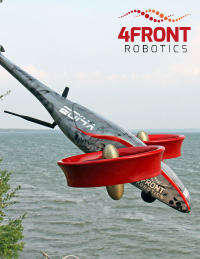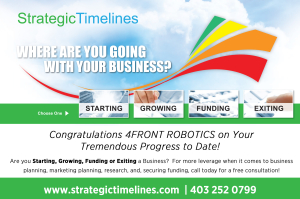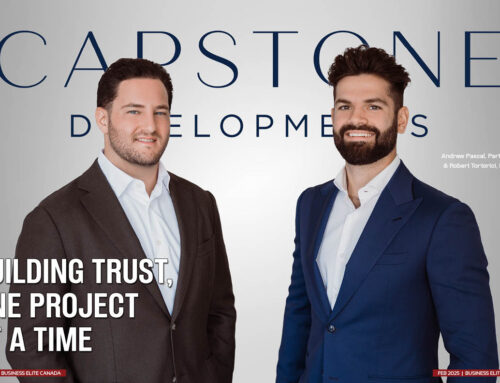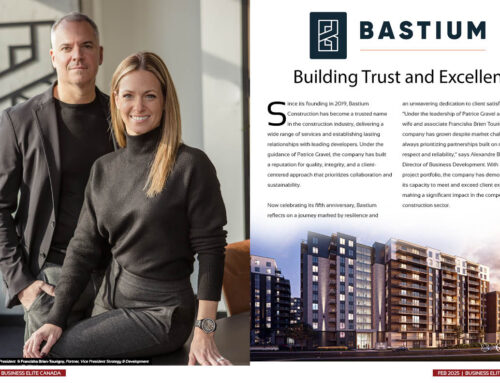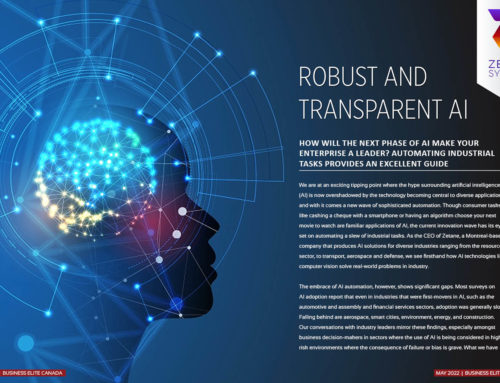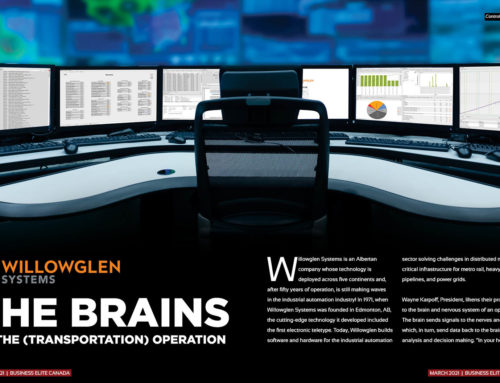Drones in confined spaces; company pushing the boundaries with no limits in sight
~ By Emily Innes
The founder and president of 4Front Robotics was the 2014 winner of the prestigious Alberta-based ASTech Awards for Outstanding Achievement in Applied Technology and Innovation for his company’s contributions to revolutionizing unmanned aerial vehicles (UAVs).
Alejandro (Alex) Ramirez-Serrano, PhD, and his company, 4Front Robotics, have been capturing awards and attention since its launch in October 2012. 4Front Robotics’ autonomous ground vehicles (UGVs) and UAVs – commonly referred to as drones – have the unique capability of manoeuvring in confined spaces. The devices have the potential to solve complex problems for a number of civil sectors. Missions using the devices have included pipeline and power line monitoring, search and rescue, infrastructure inspection, terrain 3D imaging, and environmental monitoring of water and air quality.
“We identified a need to be able to deploy robotic systems in confined spaces like collapsed buildings, in the mining industry or in different sectors where people are put to work (in risky environments),” Dr. Ramirez-Serrano told Business Elite Canada. “For example, in the oil and gas industry . . . workers are typically sent inside storage tanks to inspect them (but)those tanks are usually filled with hydrocarbonous gas making them potentially explosive. . . so that is why we started developing robots to be able to penetrate those spaces.”
4Front Robotics’ drones have unique ability to twist
4Front Robotics’ Navig8 family of UAVs are able to perform acrobatic maneuvers that no other aircraft can, whether manned or unmanned. This is possible due to the UAV’s capability to change attitude (position and orientation — roll, pitch and yaw) on three axes/dimensions, as well as change velocity on the aircrafts’ three axes and in the three spatial dimensions. They can change directions at zero airspeed and at negative airspeeds – moving backwards. These characteristics enable these UAVs to perform hover pitch maneuvers that enable them to land and take off from unprepared terrains including from sloped terrains (no need for flat horizontal surfaces or runways),something that no helicopter or other aircraft can perform.
“We developed techniques that allow our vehicles to turn and twist, move, and rotate,” said Dr. Ramirez-Serrano. “Associated to that, there are also other techniques to navigate in a confined space. When you fly in confined spaces, the propeller’s downwash (the downward deflection of an airstream by an aircraft wing or helicopter rotor blade) bounces off the wall, the ground and the ceiling, and that is pushing and sucking the vehicle. So we have developed control techniques that the vehicle uses to forecast the downwash effects and automatically compensate for such disturbances.”
Dr. Ramirez-Serrano, who was born in Mexico, has had an interest in robotics since his childhood. He began his path towards the development of robotics with a bachelor’s degree in mechanical engineering in his native country. Following that, he completed a master’s degree in mechanical and aerospace engineering at the Illinois Institute of Technology in Chicago and a second master’s in computer science at Tecnológico de Monterrey (ITESM) in Mexico. In 2000, he received his doctorate degree in mechanical and manufacturing engineering in Toronto.
After being employed in a few international jobs in the field, Dr. Ramirez-Serrano headed back to Canada to work as a professor at the University of Calgary, Schulich School of Engineering, Department of Mechanical and Manufacturing. He is also the founder and director of the Autonomous Reconfigurable/Robotic Systems Laboratory (AR2S-Lab). The laboratory performs research and development in the areas of unconventional UVGs and UAVs, reconfigurable intelligent mobile robotic systems, swarm robotics, intelligent control for UAVs, and civil applications of mobile robotics.
Dr. Ramirez-Serrano said that his past experience and his vision to develop robots to solve a number of current problems faced in a number of areas led him to start his own company. “When I was conducting research in different robotic systems and devices targeted to help people in homes and industry at ABB Corporate Research (a research centre in Sweden) and then at the university, there were a number of individuals and organizations identifying some of the (devices) that we were developing as potential commercial items that could be developed for the consumer market,” he said.
“Then we started investigating in which ways our know-how and our experience with different robotic technologies could be used and we found out that the drone industry was starting to emerge. At the time it was not as strong as it is today.”
While his university work focused on outdoor environments, on his own time Dr. Ramirez-Serrano worked for about eight years to develop his UAV that could be marketed for confined spaces. Such environments are found in numerous sectors including urban search and rescue, policing, mining, and critical infrastructure inspection. Now his drone technology and systems can be considered a game changer due to their ability to perform complex maneuvers at zero speed and be deployed in GPS (global positioning system) denied spaces.
Minimal marketing needed
The units are starting to sell, according to Dr. Ramirez-Serrano, even though the company has done very little advertising. 4Front Robotics primarily focuses on attending trade shows and exhibitions, such as the recent energy sector exhibition show, Global Petroleum Show, held in June in Calgary and the wearable technology event, Make Fashion – Wear Technology, in March. He noted that the company has also received a lot of positive word-of-mouth marketing and “those have been our best promoters”.
“We have been fortunate or lucky that usually when we have shown our demonstrator units to organizations and people at trade shows and at different events, they immediately identify the benefits of those systems for their operations,” said Dr. Ramirez-Serrano. “We do not really have to educate the customers or the users on our systems. They have been able to identify the effectiveness and the user friendliness of the proposed systems to accommodate and solve their needs.”
As the devices are intended to be used in a variety of scenarios, they are fully scalable, which Dr. Ramirez-Serrano noted is another distinguishing factor of 4Front Robotics’ drones.
“The price of the drone is based on the size of the drone and the different options that we can add or remove – it completely depends on the needs of the clients,” he said. “They (can also be customizable). We have some systems that could satisfy a number of needs, but we can easily customize specific requirements because the designs are really modular.”
The cost of the units ranges from $40,000 for smaller battery-operated machines to large engine-powered machines for up to $250,000.
Rules and restrictions on drone usage
A challenge for UAV manufacturers is working within the regulations set by Transport Canada regarding drones. No vehicles under 25 kilograms can be flown above 400 feet. Another limitation is that UAVs cannot be flown beyond the operator’s line of sight. “In terms of regulations, that is something that we are going to have to overcome in order to push the industry a little bit forward, a little faster, because there are many cases where companies and people would like and need to fly beyond their line of sight to solve their problems.”
Dr. Ramirez-Serrano noted that this regulation does not particularly hinder their missions because they are usually working on private property and inside structures.
The next step for UAVs, according to Dr. Ramirez-Serrano, is to further develop their method for “sense and avoid” as they will increasingly be flown in closer proximity to buildings, power lines, within tighter confined spaces (such a beneath the tree canopy), and other UAVs. He wants the machines to be able to adapt to situations as they change, and essentially think for themselves. The world is dynamic and environmental/mission conditions change all the time. Technologies will need to automatically adapt accordingly to facilitate their use.
“I think the future of the industry looks bright,” said Dr. Ramirez-Serrano. “Many people are aware of the advantages that drone technology will bring to particular industries (such as)search and rescue, policing, agriculture, energy, construction. . . In terms of where we are going now, we are trying to enhance our vehicles to be able to fly faster and be able to physically manipulate the space and the environment(surrounding them).”
More information can be found at www.4frontrobotics.com.
OUR PROUD SPONSOR:


